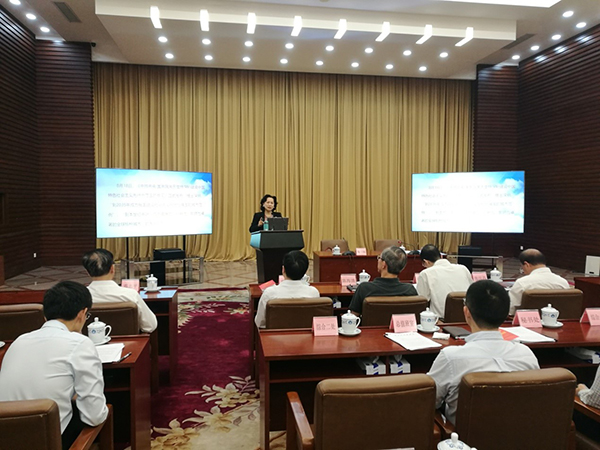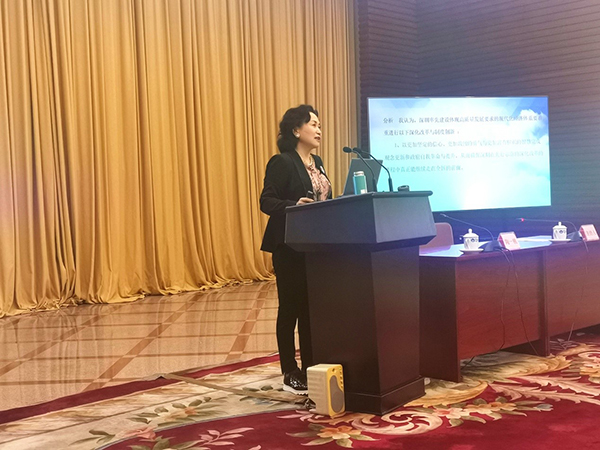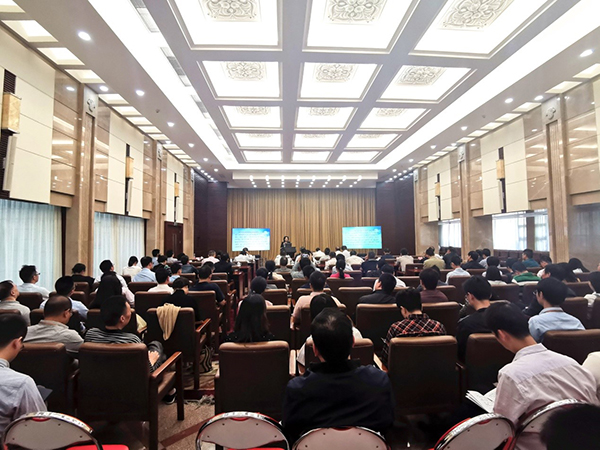On November 8, 2019, Prof. Tao, Director of the China Center for Special Economic Zone Research (CCSEZR) and President of the Belt and Road Research Institute and the Belt and Road Research Institute (Shenzhen) for International Cooperation and Development (BRRI), presented a thematic report titled Theoretical and Practical Significance of Building into a Pioneering Demonstration Area of Socialism with Chinese Characteristics, at the invitation of the General Office of the People's Government of Guangdong Province (PGGP). The meeting was presided over by Mr. Chen Haiqing, a member of Party Leadership Group of PGGP and the Party Committee Secretary of the General Office of PGGP, and attended by over a hundred of Party members, cadres and workers from the General Office of PGGP.
A scene at the meeting
Prof. Tao explained in simple terms the concepts proposed in the Opinions of the Central Committee of the CPC and the State Council on Supporting Shenzhen to Build a Pilot Demonstration Area of Socialism with Chinese Characteristics (the Opinions). She shed new light on the Opinions from the following aspects: 1) Overall framework and analysis of the "Opinions"; 2) Why history has once again chosen Shenzhen; 3) "Special Economic Zone" and "China’s Path"; 4) Pilot demonstration area and the Guangdong-Hong Kong-Macao Greater Bay Area; 5) Institutional constraints on pilot demonstration.
Prof. Tao noted that the Opinions lay out in a far-sighted manner five grand strategic goals that include building Shenzhen into: a leading player in high-quality development, a pace-setter in law-based governance, a model of urban civilization, a good example of people's livelihood and happiness, and a pioneer in sustainable development.
In her opinion, the internal logic behind taking the lead in building a modern economy that reflects high-quality development is that: innovation serves as the engine of economic growth, modern industrial system acts as the foundation, comprehensively deepening reform and opening-up provides the institutional impetus, and bolstering the construction of the Guangdong-Hong Kong-Macao Greater Bay Area (the Greater Bay Area) is an important function and also the goal to give play to the role of the Greater Bay Area as a regional engine.
She underlined the following three points: First, building such a modern economic system is not simply a matter of developing the economy, but rather of deepening the reform and constructing a law-based society. Without law-based governance that protects properties and the right of free and equal exchanges, it is impossible to provide fundamental system guarantee for building such a modern economic system.
Second, system innovation in favor of high quality development is the prerequisite for building such a modern economic system. Like a tree grows from the ground, a system works best in an institutional setting. Without an institutional setting that assures high-quality development, it is impossible to build a modern economic system that reflects high quality development.
Third, the strategy of driving growth by innovation is essential to the construction of a modern economic system. High-tech and strategic emerging industries provide core impetuses for building such a system whose ultimate goal is to create an international innovation and technology hub in return. The goal matches the positioning of Shenzhen as a city started from reform and innovation, outlined in the GBA regional development planning.

 Prof. Tao Yitao in the report
Prof. Tao Yitao in the report
In Prof. Tao’s mind, Shenzhen was chosen again for the following three reasons.
I. A “pilot demonstration area” is essentially a pioneer of practical exploration and system innovation. Shenzhen is born to be such a pioneer. Four decades ago, Shenzhen was chosen to be a special economic zone with a mission to transform from a planned to a market economy, and to explore a road from widespread poverty to common prosperity, by pioneering new approaches. Four decades later, the city, as the most typical and successful SEZ in China, is charged with a more profound mission: to build a pilot demonstration area of socialism with Chinese characteristics.
II. To “keep in mind the strategic intention of the CPC Central Committee”, we must understand what SEZs mean to the reform and opening-up and system changes of China. Shenzhen is the earliest and most successful practitioner of the strategic intention. She pointed out that the strategic intention indicates that SEZs are neither momentary, nor simply a product of special policies, let alone a stopgap solution. As a product of special policies, SEZs finished its mission to explore and complete the transition from a planned to a market economy. As a system deployment, SEZs are the best path to realize social transformation at minimum cost, in such a vast and unevenly developing country. As a crucial practice mode of progressive reform, SEZs mitigate the risk of reform and opening-up of China, and improve the performance of system changes. This strategic intention also presents us that SEZs are not simply a city, but an explorer of the path for changes of Chinese social system, a pioneer in building the market economic system of socialism, and an integral component of Chinese path.
III. “Building a pilot city of a modern socialist country” requires us to firmly walk down the path of reform and opening-up, and grasp the opportunities presented by the GBA initiative to implement the overall requirements of high-quality development and the strategy of innovation-driven development. With the wealth and system advantages accumulated over the past 40 years, Shenzhen is the inevitable undertaker of this mission.
The attendees attached great importance to Prof. Tao’s lecture and said it deepened their understanding of the Opinions. The lecture successfully ended with the warm applause of the attendees.


